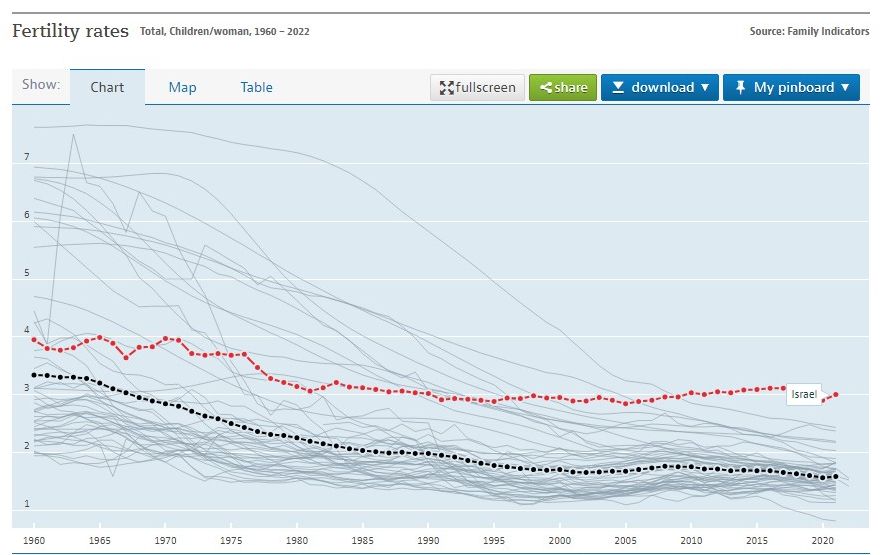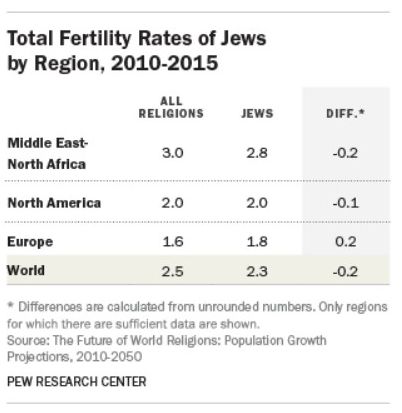Demographic Collapse: Several Case Studies
In this post, I examine fertility rates and policies from Hungary, Denmark, South Korea, Japan and Israel.

The first post in this series outlined why we should care about the demographic decline and paints a bleak picture of reverse network effects, reverse economies of scale, infrastructure deterioration, and unsustainable social safety nets. In this post, I look at how several example countries have tried to address their fertility rate decline.
I need to point out up front that some programs, like direct allowance checks per child from the government, might seem like they qualify as being aimed at fertility but are more political tools. For example, the Child Tax Credit in the US, is $3,000 per child under 18, and is a fully refundable, meaning you get the full amount applied directly toward your taxes, not a write-off. But the stated goal of this policy is to "reduce child poverty" not stimulate a fertility rate increase.
Most developed countries have child tax payments or allowance, and while a welcome side effect might be a fertility boost, it is almost universally not their aim. However, they have become a model in many countries for their fertility policies, so are important information to evaluate.
Hungarian Family Policy
Under the second Orban Government in 2010, Hungary went from spending almost nothing on family policy to one of the countries spending the most per GDP. Estimates are now 4% of Hungary's GDP is spent on addressing the demographic decline, with a complicated policy framework including:
- Family allowance - 12,200 Hungarian Forint HUF for 1 child ($34); 26,600 HUF for children ($74); 48,000 for 3+ children ($133) - source
- Tax breaks - 66,670 HUF ($184) for 1 child; 133,330 HUF ($369) for 2 children; 220,000 HUF ($608) for 3+, per month per child! This is a lot considering the average income in Hungary is 493,000 HUF ($1364/month). This means that average couples having 3 kids can live basically tax-free. - source
- Housing Support - CSOK gives grants for family housing purchases; 600,000 HUF ($1660) for 1 child families; 2,600,000 HUF ($7200) for 2 child families; and 10 million HUF ($27,600) for 3+ child families. The average new home price in Hungary is 54 million HUF. This program also includes a reduction of VAT on homes from 27% down to 5%. - source
- Maternity Benefit - 24 weeks maternity leave at 70% salary, 18 more months of maternity leave at 70% salary capped at double minimum wage. - source
- Childcare subsidy - up to 70% of either the mother's or father's income. - source
- Marriage subsidy - 5000 HUF/month ($13) - source
- Extra paid vacation - parents with 1 child get 2 extra days/year, 2 children get 4 days, 3 or more 7 days. - source
- Other benefits - certain medical care for children, free public transport for children, etc
That's a complex web of benefits. It's important to note here too, these programs started back in 1967 with the implementation of the first Child Care Allowance, so they are not new. In 1985, paid maternity leave was introduced at 75% of salary for one year. The results have been the same each time. The programs had a brief one or two year bump in fertility, followed by a resumption of the decline.
Since 2010, they've pulled out all the stops. Surely, spending up to 4% of GDP on these family policies would have a major impact, right? Most of these policies started in 2010 and on the chart below, we can definitely see an effect.

From a low of 1.23 in 2011, the fertility rate has increased to 1.59. That is a 23% increase, but still very far below replacement of 2.1. The effect is also waning as the fertility rate plateaus under 1.6. There is also some debate about a quirk in the math for Hungary's Total Fertility Rate. It has been said that the rise since 2011 is an artifact of delaying the first child and how that effects the formulas.
Perhaps, an argument could be made that even more government subsidies, like spending 10% of GDP, would boost it closer to replacement, but it starts to get politically impossible to raise taxes on an ever smaller group of productive citizens, while you are also paying more in benefits to your aging population. A fertility rate of 1.6 doesn't fix the decline, each year you will have fewer workers to squeeze taxes out of, and if they decide to have kids, they can get out of taxes almost completely anyway.
Hungary's policies, while a great and noble attempt, are not sustainable.
"Do it for Denmark"
This creative ad campaign by a Danish travel agency Spies Rejser was launched to directly address Denmark's fertility problems. I include it, because it is a creative effort by the free market to address these problems.
Last year we at Spies Travels launched the 'Do it for Denmark'-campaign in order to address the historical low birth rates in Denmark. It turned out quite successful, we made the Danes travel more, have more sex and reproduce for their country. - Spies Travel YouTube
Some Danes are growing increasingly concerned about social services and other early signs of demographic decline. This campaign was followed by at least two others, "Do it for mom" and "Do it Forever".
There was some success, as Spies claims, but they were fleeting. I've seen different results claimed around specific numbers of babies born, like being responsible for 1,200 or 1,600 additional babies born. But we can look directly at the fertility rate. In 2014, when the campaigned launched the fertility rate was 1.69. By 2016, it had a brief jump to 1.79, but by 2019 it was back down to 1.70. This was a 6% maximum increase in fertility that lasted only 3 years, despite repeated campaigns.

As alluded to above, Denmark has a long-term program of subsidies per child, called the Child Cheque. This program consists of quarterly tax-free payments to parents per child, that declines with the age of the child. These policies do not seem to be directly aimed at the fertility decline, they are more of a child tax-benefit you'd find in most progressive tax structures. Despite this, they are more generous than South Korea and Japan with much worse fertility declines described below.
- 0-2 years of age = 4,629 DKK ($665)
- 3-6 years of age = 3,666 DKK ($527)
- 7-14 years of age = 2,883 DKK ($414)
- 15-17 years of age = 961 DKK ($138)
Infamous South Korea
South Korea has the lowest fertility rate in the world at 0.78.

South Korea has implemented a series of 5-year plans to address its low fertility rate problem starting as far back as 2006. They are currently on The 4th Basic Plan for Low Fertility and Aging Society (2021–2025). In total, they've spent over $200 billion on various schemes for childcare and other things, yet fertility continues to drop.
- Birth grant - mothers are given a grant of 2 million won ($1500) for each birth.
- Child allowance - children under one get 700,000 won ($528) and children under two get 350,000 won ($264) per month. This is an increase implemented in 2023 from previous smaller allowances.
- Paid paternity leave - 2 years at 80% of salary, up to $1,338/mo. The average monthly income for men in South Korea is $2,880. Source
- Reducing work week - from 68 to 52 hours/week. South Korea has the second highest number of hours worked in OECD countries. This policy is enforced through heavy fines on the employer. The goal of this policy is to create a better work/life balance and hopefully increase fertility. Source
Despite the seriousness of the problem and government efforts, the younger generations are rebelling against most of these policies. There is a significant number of young people that are part of the Sampo Generation, where they give up on dating, marriage and children.
In 2016, the previous government launched a heat map of marriages, births and women of childbearing age across the country, hoping this would encourage competition between different regions. Instead, it was taken down after one day due to a public outcry from South Korean women, who accused the government of seeing them as “reproductive organs”. - source
The excuses for not having children in South Korea are similar to other countries, career, cost, and so forth, but their is a dangerous undercurrent that is, perhaps, shared in other places but to a less extent - they are blaming gender inequality. In a Confucian society, traditional gender roles are heavily stressed, the women are tasked to take care of the kids and the house work. Studies have shown, in South Korea today in dual income households, the women spend four times more time doing housework than men. It would not be surprising to hear this kind of thinking early on in a demographic transition, but as fertility rates drop so low and the signs of the problem become keenly felt, traditional gender roles seem to rise in popularity elsewhere. We see this with the "trad-wife" movement in the US, the rise of conservative and populist movements around the world from South America to Sweden to India. However, in South Korea the scapegoat of gender inequality is only intensifying.
Despite spending hundreds of billions of dollars to address the fertility rate, the downward spiral is only accelerating in South Korea. The youth are rebelling against everything the government tries. In 2016, then President Moon Jae-in said, “We are now at the last golden time to fix a serious population problem. We must now focus on how marrying and giving birth doesn’t limit the lives of women.” That "last golden time" was almost half a generation ago, and things have only gotten worse.
“We are now at the last golden time to fix a serious population problem. We must now focus on how marrying and giving birth doesn’t limit the lives of women.”
Japan Slow Grind
Public awareness of the fertility decline in Japan started with the "1.57 Shock". When the fertility rate for 1989 was reported, media headline across Japan reported on this record-breaking low fertility of 1.57. The previous well-known record in the country was from 1966, a one-off drop in fertility in the year of the “Hinoe-Uma (Fire-Horse)”, a superstition that women born in that year will have a bad personality and kill their husband. The alignment happens every 60 years, so, breaking that record was truly shocking for the Japanese. The 1966 drop is clearly visible on the fertility rate chart. I'll also note, the 1.57 Shock coincided with the Nikkei collapse of January 1990. I'm not saying they are connected, but could both be parts of a larger puzzle.

Government allowances for parents started in Japan as early as 1972, but only for parents with 3 or more children with a low income. This program has been expanded throughout the years and now covers first and second born children, but it is still dependent on income and remains very modest.
- Child allowance - dependent on income.
If qualify as low income:- ¥15,000/month ($101), per child under 3 years old
- ¥10,000/month ($68), per child over 3 years old in primary school, plus ¥15,000 for the 3rd* and onwards
- ¥10,000/month, per child for Junior High School students
- Middle income:
- ¥5,000/month ($34), per child
- no allowance for high income earners
It was after the 1.57 Shock that policies started coming out to address fertility straight on. Twelve months of parental leave was instituted in 1992, but it wasn't required paid leave until 1995. These policies also only apply to companies with more than 30 employees, and women tend to work for smaller companies at a higher rate then men.
In 1994, they rolled out the "Angel Plan", which offered counselling for couples and encouraged men to take a more equal share of housework and childrearing duties. The "New Angel Plan" in 1999 added more childcare centers, but funding problems limited the success of that plan.
Japanese fertility rate bottomed in 2005. I could not find a specific program that was implemented or expanded in that year. The only correlation I did find was the Nikkei 225. In 2005, the Nikkei finally showed some signs of life, breaking out of a multi-year bottoming. Then the GFC hit, but the market held up okay, resuming it's upward trend by 2013.

The rally in the Nikkei over the last several years, has not coincided with a continued rise in the fertility rate, which peaked in 2015 and has resumed its decline.
That brings us to the current year, Japan has unveiled it's new and improved fertility boosting program. Children’s Policies Minister Masanobu Ogura's plan includes more government subsidies, access to more student loans, and increasing availability of childcare services. Of course, none of this is new, just bigger. But they are at least realizing the severity of the issue:
Ogura said the next few years are possibly “a last chance” for Japan to reverse its declining births. - AP
Another part of the new plan is to "change the cultural mindset toward more gender equality both at work and at home. The proposal also includes increased government assistance to companies to encourage more of male staff to take paternity leave." That sounds like the counterproductive scapegoat being used in South Korea.
Israeli Success?
The ONLY country where fertility rates have leveled out above replacement is Israel. Many countries are still above this, but they have not leveled out. They have managed to keep their fertility rate at 3 since 1980.

Jews living in the rest of the world do not fair so well. Globally, their fertility rate is 2.3, just above replacement, but it is falling in the US and Europe along with total fertility rates in those places.

Israel does have some government child allowances like most other countries, but they are relatively modest. Parents receive a fixed amount per child each month.
- Child allowance - 156 Israeli New Shekel (NIS) for the 1st child ($41), 197 NIS ($52) for each 2nd, 3rd, and 4th child. And 156 NIS for 5th and more. A family with the average 3 kids would receive $145/month.
Israeli women have a labor force participation rate of 60% as of 2022, which above the OECD average of 51%. And women are 47% of the total workforce. So, it is not that women have more time or are getting more tax breaks to have children. Women in Israel rank far above the OECD average for female education, as well.
Some people think it is the ultra-religious in Israel who are responsible for the high fertility rate. True, their fertility rate is still very high at around 7, but even the secular population has a fertility rate at replacement. Recent polls have also found that only 1/3 of the population of Israel say that religion is "very important" to them, higher than Western Europe, but lower than close neighbors like Greece at 56% with a fertility rate of 1.34.
Israel has all the things typically blamed for low fertility, low government subsidies, high female labor participation, high female education, yet they have succeeded in holding their fertility rate above replacement. Their secret sauce is the unique culture around children and their people. Children are celebrated and larger families are the aim. It is seem as a cultural imperative for their people to have children.
It is important to not put too much emphasis on the Israeli success, because it is unlikely to be replicated in other places. What's happening in Israel directly contradicts what we see in other countries. It is also not an example of how to RECOVER from significant sub-replacement level fertility, because they never slipped below it in the first place. No society in history has ever recovered from a fertility rate significantly below replacement.




